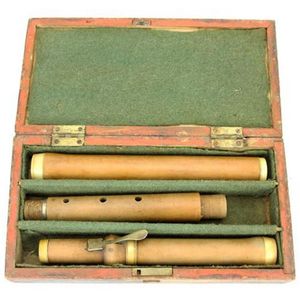D'Almaine Ivory Flute in Custom Box
You must be a subscriber, and be logged in to view price and dealer details.
Subscribe Now to view actual auction price for this item
When you subscribe, you have the option of setting the currency in which to display prices to $Au, $US, $NZ or Stg.
- Ivory - Ivory is a hard white material that comes from the tusks of elephants, mammoth, walrus and boar, or from the teeth of hippopotamus and whales. The ivory from the African elephant is the most prized source of ivory. Although the mammoth is extinct, tusks are still being unearthed in Russia and offered for sale.
Ivory has been used since the earliest times as a material for sculpture of small items, both in Europe and the east, principally China and Japan.
In Asia ivory has been carved for netsuke, seals, okimono, card cases, fan supports, animals and other figures and even as carved tusks.
In the last 200 years in Europe ivory has been used to carve figures, for elaborate tankards, snuff boxes, cane handles, embroidery and sewing accessories, in jewellery and as inlay on furniture. Its more practical uses include being used for billiard balls, buttons, and a veneers on the top of piano keys.
The use and trade of elephant ivory have become controversial because they have contributed to Due to the decline in elephant populations because of the trade in ivory, the Asian elephant was placed on Appendix One of the Convention on International Trade in Endangered Species (CITES), in 1975, and in January 1990, the African elephant was similarly listed. Under Appendix One, international trade in Asian or African elephant ivory between member countries is forbidden. Unlike trade in elephant tusks, trade in mammoth tusks is legal.
Since the invention of plastics, there have been many attempts to create an artificial ivory - Boxwood - Boxwood is a hard, yellow coloured, close grained timber. In the 19th century it was often used for inlays, especially stringing, because of its contrasting colour to the darker timbers of the carcase. Stringing is the inlay of a narrow strip of veneer of a lighter colour, such as boxwood along or close to the edges of an object that has been veneered in a darker timber such as mahogany.
Because of its fine grain and resistnce to splitting or chipping it has also been used for treen, turnings, carvings and other small wooden items, such as chess pieces.
This item has been included into following indexes:
Visually similar items

Thirteen various passenger carriages, including Hornby, Tri-ang and Lima, unboxed (13).

Hornby OO gauge 'Spirit of Progress' train loco and carriages, comprising of diesel locomotive, 2 first class carriages, 2 baggage cars and a dining car

A boxed guilloche enamel silver gilt writing set, Cartier, circa 1920 comprising a pen rest, a nib holder, a double ended eraser, a pencil and a pen knife, the pen rest of tapering oblong form, with white enamel jeweling to the edge, the blue guilloche ena

Pelikan fountain pen, with box
